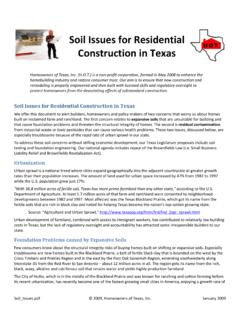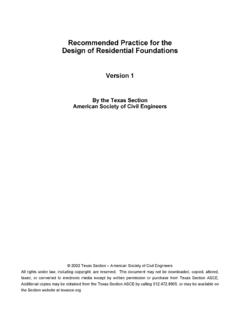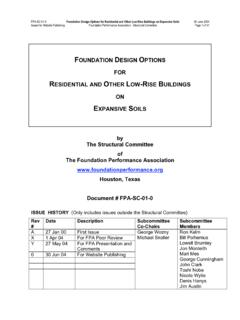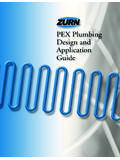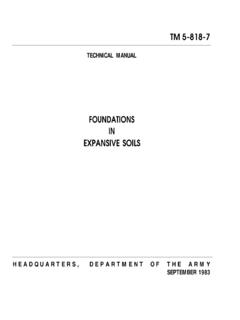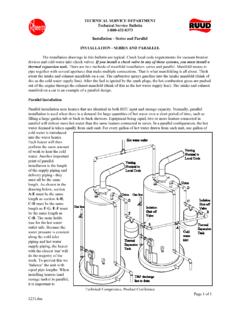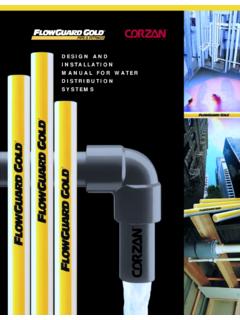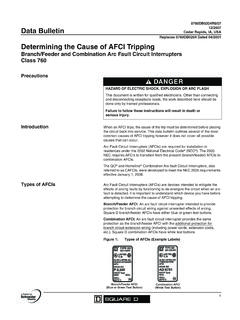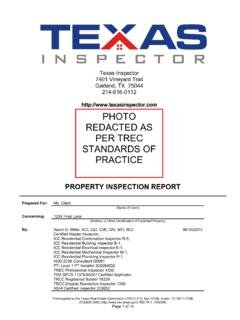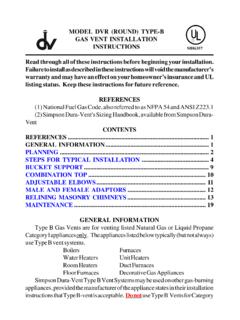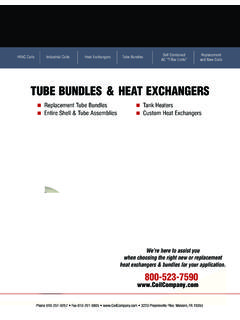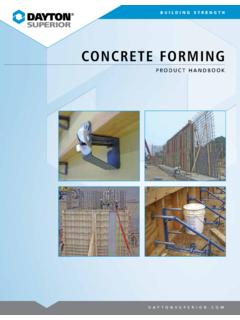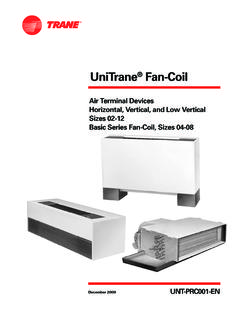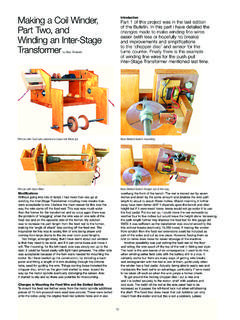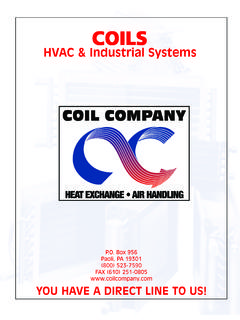Transcription of Carefully Choosing Coil Cleaners - Texas Inspector
1 RSES Journal MAY 2014 Images courtesy of RectorSeal JAMES BOWMANC arefully Choosing Coil Cleaners Proper selection of chemicals and cleaning techniques are critical in A/C coil improper cleaning solutions and techniques for air-conditioning condenser and evaporator coils can not only damage the coils , but it can also cause long-term premature refrigerant leaks and heat-transfer reductions. Unknowing service technicians may be slowly destroying most of the coils they are supposedly degreasing, cleaning and brightening. The wrong coil cleaner on fins can show visible destruction, but the hidden danger is the electrolytic breakdown of the all-important heat-transferring bond between copper tube and fin that typically remains unseen. For example, several service techs misdiagnosed a home-owner s complaint of high electric bills and insufficient cooling as the result of a slightly corroded and dirty outdoor coil. They thoroughly cleaned it. However, the problem persisted until a thorough exam found little heat transfer from tubing to fins.
2 The bonds had apparently disintegrated from another service company s improper rinsing after applying chemical coil Cleaners . The only solution was a coil the wrong product can also potentially endanger patrons as well as service techs. For example, a popular restaurant chain location in Nebraska called for service on a reach-in freezer that was installed inappropriately next to deep-frying equipment. As a result, the freezer s condenser coil had caked layers of grease. Unfortunately, the service tech used a high-pressure aerosol degreaser designed for outdoor use only, even though the EPA-mandated vapor harmful warning label emphasized use outdoors or in Coil-cleaning chemicals are available as foaming or non-foaming liquids. The foaming strategy is designed to be dispersed as a liquid so that it reaches deeply into small inaccessible coil surfaces. Coil Cleaners come in several application methods, such as a hand-held foaming aerosol can or a hand-held high-pressure solvent aerosol spray 2014 RSES Journal 23 Carefully Choosing Coil Cleaners omTest Tools HVACR P ros TrustWireless Dual In-Duct PsychrometerMo del: SDP2 Monitor Evap or ator ConditionsCircle Reader Service No.
3 51well-ventilated areas. Consequently, the degreaser s strong fumes necessi-tated closing down the restaurant for the day to exhaust the sickening toxic chemical odors. The service tech was rushed to the the chemical to the applicationCoil Cleaners come in several appli-cation methods, such as a hand-held foaming aerosol can or a hand-held high-pressure solvent aerosol spray can. They are also available in bulk liquids that range from 1-gal to 55-gal containers, typically concentrated for a 3:1, 4:1 or 5:1 mixture with water ratio. The mixed product should be applied with a minimal-pressure pump sprayer. Power washers should be avoided because they damage coil fins and disperse chemicals into unwanted areas. Powdered chemical concentrates for mixing in water have the disadvan-tages of potentially clogging sprayers or blowing into the service tech s eyes or respiratory system on windy days. Coil-cleaning chemicals are available as foaming or non-foaming liquids.
4 The foaming strategy is designed to be dis-persed as a liquid so that it reaches deeply into small inaccessible coil surfaces. Afterward, its foaming action helps dissolve, dislodge and lift out har-bored contaminants. Chemicals are most effective when the foaming process is delayed a few seconds after spraying, so that the liquid can pen-etrate into deep, inaccessible coil areas. A chemical that foams pre-maturely or immediately out of the sprayer head will not have time to access these hard-to-reach also vary by pH, such as acid-based, non-acid and self-rinsing Cleaners . Non-acid based treatments must be rinsed in the manufacturer-specified allotted time, typically about 8 minutes, or else the alkalinity will eat away at the fins instead of leaving them bright and shiny. It is also important to understand basic chemistry, especially the acid/alkalinity pH scale, which has a cri-teria range from 0 to 14. Extreme acid is 0, extreme alkalinity is 14 and 7 is neutral.
5 It is well-known that extreme acidity is corrosive. However, extreme alkalinity at the opposite end of the scale can be equally corrosive. Acid coil Cleaners and non-acid coil Cleaners have a pH of around 0 1 and 13 14, respectively. On the neutral middle of the scale, self-rinsing evaporator Cleaners Chemicals are most effective when the foaming process is delayed a few seconds after spraying, so that the liquid can pen-etrate into deep, inaccessible coil areas. RSES Journal MAY 2014 Chemical coil Cleaners should be sprayed from the outside in, but rinsing should be from the inside out, so as not to rinse chem-icals into internal parts of the system. Additionally, some coil Cleaners must be rinsed in no more than 8 minutes after application to prevent any corrosive effects to the fins or designed to be a fairly neutral detergent with a slight alka-linity of 8 on the scale. Another industry misconception is the term detergent. Many coil Cleaners are detergents that are custom-formulated for refrigeration systems, but that does not mean they can be substituted with dish or clothes-washing detergents, many of which have chemicals that are corrosive to service technicians cleaning government build-ing A/C systems, it is important to note that some agencies, such as the Post Office, prohibit trichloroethylene, a chemical popularly used in some brands of coil Cleaners .
6 It is always important to investigate a school district, hospital or government building s restrictions on particular chemicals, which can be found on every brand s Material Safety Data Sheet (MSDS). Stocking the truck and shopMost service companies carry just two different coil Cleaners , an evaporator cleaner for inside equipment and a foaming-acid condenser cleaner for outside equipment. While stocking just two varieties saves truck and shop space, service techs can get caught with the wrong chemical for an application on a service call, and then use it inappropriately to save time. Those two products are fine for most residential applica-tions. However, a commercial service tech may need to stock a wider range of coil Cleaners . For example, restaurant rooftop coils commonly get filled with cooking grease from nearby exhaust vents. This situation calls for a third product stocked on the truck, such as a foaming non-acid coil cleaner . There is also the choice of carrying hand-held aerosol cans vs.
7 Jugs of concentrate and spray applicators. The cans are more expensive per ounce of chemical than jug It Might Look Clean, thin film of mold or other biological growth acts as insulation on HVAC-system coils and reduces heat-transfer energy efficiency. Studies have proven that just a bio-film on coils can reduce the free area and increase air velocity up to 9%. The result is a system with higher static pressure across the coil for which it was designed. Eliminating biological growths can result in up to a 30% cooling-capacity increase compared to a dirty coil. This results in significant energy 2014 RSES Journal 25 Tecumseh condensing uniT PromoTionPromoTion Period: APriL 1 - AugusT 31, 2014 Tecumseh is giving conTracTors An even beTTer reAson To any Tecumseh condensing uniT or uniT cooler and earn greaT products deserve high-quality rewards. That s why Tecumseh reward points say Thank you! in the best way possible. From the latest Taylormade driver to wenzel camping equipment, purchase and install Tecumseh condensing units and unit coolers and the big chill3 promotion provides you with the opportunity to earn some great rewards.
8 2014 Tecumseh Products company. all rights isit your Tecumseh Authorized Wholesaler or for more 14/14/14 10:56 AMCircle Reader Service No. 52 The aluminum, copper and metal alloys used in the manufacturing of fins and tubing of mini-split evaporator coils , as well as the unit s plastic blower wheel, are more sensitive and must be cleaned with a safe, non-acid cleaner . concentrates. However, cans are more convenient to bill on an invoice, whereas partially used jug concentrate is more difficult to calculate. Indoor coils require a self-rinsing coil cleaner to mini-mize post-cleaning messes and prevent residual chemicals that can potentially enter the airstream supply air that occupants breathe. Self-rinsing chemicals use condensation formation on the air conditioning coil to drip away any residual chemicals into the unit s evaporator pan and drain. An important factor in self-rinsing Cleaners is that they do need manual rinsing in the winter heating system because there is no air-conditioning condensation formation to rinse the chemicals away.
9 The drain pan and drain should always be included in the cleaning processes of indoor units for unobstructed condensate flow. Special care for mini-splits Ductless mini-splits require additional care when cleaning the evaporator coils . The aluminum, copper and metal alloys used in the manufacturing of fins and tubing of mini-split evaporator coils , as well as the unit s plastic blower wheel, are more sensitive and must be cleaned with a safe, non-acid cleaner . The cleaning solution should not only be safe for the coils , but also non-toxic for the building occupants, such as the chemically sensitive or seniors in nursing homes, hospitals or other healthcare facilities that can breathe residual chemicals left on coils . Therefore, non-fragrant, bacteria-static formulas are also ideal for healthcare environment occupants with high sensitivities to odors, chemicals, airborne microbial con-taminants or gaseous chemicals. Manufacturers of cleaning solutions have recently catered to this specialty market with non-caustic, no-rinse formulas that expedite cleanup.
10 Additionally, in many cases mini-splits have condensate pumps with piston, diaphragm or peristaltic operations that can become damaged with caustic Cleaners . RSES Journal MAY 2014 Coil-cleaning Guidelines 1. Shut off unit before cleaning. 2. Always wear protective clothing, eyewear and gloves. 3. Avoid skin contact with coil Cleaners . 4. Do not inhale the vapors of the coil cleaner . 5. When mixing, always add the concentrated coil cleaner to the water in the sprayer. 6. Do not use sprayers with aluminum parts. 7. Always read coil- cleaner directions and follow dilution ratios. 8. Avoid back spray from wind. 9. Liberally apply coil-cleaning solution to coil surface. 10. Let solution work for 5 minutes before rinsing. 11. Rinse coil and surrounding area thoroughly with low-pressure water. 12. For cooking-grease applications, allow a non-acid coil-cleaning solution to work 8 minutes before rinsing.
